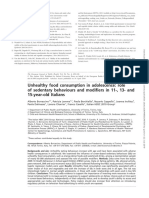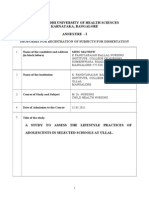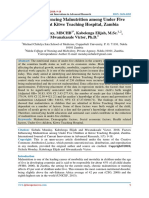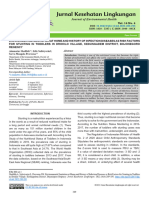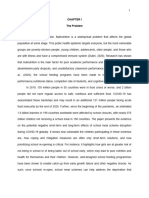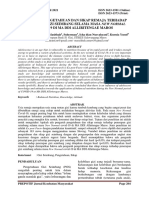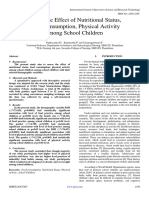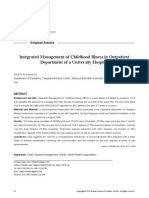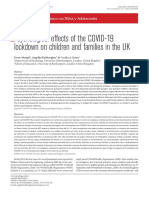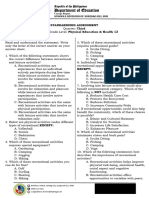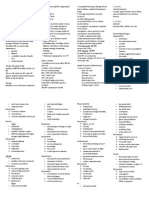Professional Documents
Culture Documents
Effectsof COVID-19 Lockdown On The Lifestyle of Children A Cross-Sectional Survey
Original Title
Copyright
Available Formats
Share this document
Did you find this document useful?
Is this content inappropriate?
Report this DocumentCopyright:
Available Formats
Effectsof COVID-19 Lockdown On The Lifestyle of Children A Cross-Sectional Survey
Copyright:
Available Formats
Volume 7, Issue 5, May – 2022 International Journal of Innovative Science and Research Technology
ISSN No:-2456-2165
Effectsof COVID-19 Lockdown on the Lifestyle
of Children: A Cross-Sectional Survey
Dr. Dhanu Priya Patel, Dr. Anant Gopal Nigam, Dr. Shantanu Jain
Mahatma Gandhi Dental College and Hospital, Jaipur
Abstract:- contagion which resulted in the restriction of the movement
Aim and objectives: The aim of this study is to evaluate of entire 1.38 billions of Indian population. This
the effect of COVID-19 lockdown on the lifestyle of unanticipated command by the government trembled the
children aged 5 to 14 years. population in various waysembracing their lifestyle, work,
diet and mental health. The effect was not only limited to the
Methods: A random sample of 315 patients attending the adult population but also affected the children damagingly.
outpatient department of the institute between the age Lifestyle plays a crucial role in the development of a child's
group of 5 to 14 years were included. A self-administered health and personality. This unfortunate position of isolation
bilingual questionnaire containing close-ended questions created a hostile environment for maintaining the healthy
was distributed to the parents/caregivers prior to the lifestyle and behaviour of children and adolescents. The
initial consultation and written informed consent was abrupt cessation of schools and playing for children who by
taken. The questionnaire included the patients’ mandate had to stay in their homes in an attempt to attenuate
demographic information and questions about lifestyle, the spread of the disease made an unexpected change in their
dietary habits, physical activity, enthusiasm, irritability lifestyle.Such mandatory directives of locking down every
and weight gain in children during the covid-19 outdoor activities impeded children to carry out their daily
lockdown to which respondents were asked to tick the routine including regular physical activity and exercise.
appropriate option according to them.
This vicious cycle of sedentary behaviour and
Results: Out of 315 children, 148 children were female decreased daily energy expenditure might end in weight
and 167 were male. The overall mean age of the children gain.Staying indoors and living a stationary lifestyle favours
was recorded 8.85 years with a std. deviation of 2.602. the adverse mental as well as physical health of children.
The majority (66.7%) of respondents noticed the change During this lockdown, the families usually stocked food
in their child’s lifestyle-related behaviour during with longer shelf-life and high calorie-containing processed
lockdown. A statistically significant association was food which in turn disrupts normal pattern and frequency of
found between changes in snacking habits between meals eating. Children's quality and quantity of food intake have
and weight gain of the children (p-value=0.002), been changed including physical activities and daily routine.
changesbetween the participation in physical activities These habits and changes in the diet affect oral health as
and weight gain of the children (p-value<0.001) and well. The consumption of sweetened and refined food can
between physical activities and irritability/anxiety of the cause subsequent plaque deposition that eventually leads to
children (p-value<0.001). poor oral health and dental caries.
Conclusion: The covid-19 lockdown has a pronounced Hence, the aim of this study is to observe the effects of
effect on the behaviour and lifestyle of children and the lifestyle-related habits during COVID- 19 lockdown in
parents are suggested to make their children maintain a children and how it affects their overall health.
regular timetable and healthy habits to minimise the risk
of adverse effects on the child’s behaviour and health in II. MATERIALS AND METHODS
future.
A self-administered bilingual (Hindi and English)
I. INTRODUCTION questionnaire containing close-ended questions was
prepared to identify the change in the lifestyle of children
COVID-19 pandemic has led a life-changing impact and its effects during COVID-19 Lockdown. A three-point
among people across the globe including children. Likert scale was used to make the questionnaire with two
Coronavirus disease 2019 (COVID-19) is an acute polar options “increased” and “decreased” and a neutral
infectious respiratory disease that has created strenuous option as “constant”. The questionnaire included the
consequences for the global healthcare community. 1 patients’ demographic information and questions about
lifestyle, dietary habits, physical activity, enthusiasm,
On 11th March 2020, the World Health Organization irritability and weight gain in children during the covid-19
declared the status of the global pandemic and many nations lockdown.
adopted measures in order to limitthe rapidly increasing
cases.2 The questionnaires were distributed by non-clinical
reception staff in the waiting area to the parents/caregivers
On the evening of 24th March 2020, Following the prior to the initial consultation and written informed consent
outbreak of the pandemic the Indian government imposed, a was taken. The respondents were asked to tick the most
nationwide lockdown of 21 days was which was later appropriate answer according to them.
continued till 31st May 2020to limit the spread of the
IJISRT22MAY362 www.ijisrt.com 1442
Volume 7, Issue 5, May – 2022 International Journal of Innovative Science and Research Technology
ISSN No:-2456-2165
The sample included 315 new patients (167 males and habit of snacking between meals while 55.6% of children
148 females) attending the outpatient department of the showed that quantity/portion of meals/snacks is constant. A
Institute (Department of Pediatric and Preventive Dentistry, constant daily intake of fruits and vegetables was observed
Mahatma Gandhi Dental College and Hospital) between the in 47.9%of children while there is an increase in the
age group of 5 to 14 years. The survey was conducted for percentage of children consuming junk food (43.2).The
over 6 months period. Apilot study wasconductedwith the child’s probability of skipping one of the main meals
questionnaire distributed to 30 parents to test the validity of (breakfast/lunch/dinner) was found to be similar as before in
the questionnaire. the majority of children.
III. RESULTS The child’s participation in physical activities as well
as helping in household work was increased (36.2%) and
A total of 315 forms were collectedand the data were (36.5%) respectively. A majority of 85.4% of children
entered into MS Excel spreadsheet which was statistically exhibited increased screen time (e.g. T.V, Mobile, laptop,
analysed using STATA/IC-13 software. Out of 315 children, online classes). There was no change in the child's hours of
148 children were female and 167 were male (Table-1). The sleep, energy level and enthusiasm. While 52.4% of children
overall mean age of the children was recorded 8.85 years showed irritability, stress/anxiety during the lockdown and
with a std. deviation of2.602. (Table- 2). The majority 56.8% of children were manifested with an increase in their
(66.7%) of respondents noticed the change in their child’s body weight during the lockdown. (Table-3).
lifestyle-related behaviour during COVID time. 59.7% of
respondents agreed that there is an increase in their child's
Chi-square test was used for significant associations offrequency of meal and child’s weight(Table-4); participation in
physical exercise and weight (Table-5); and participation in physical exercise and irritability or stress/anxiety(Table-6).
Sex of the Child Frequency Percent
Female 148 47.0
Male 167 53.0
Table 1
Descriptive Statistics N Minimum Maximum Mean Std. Deviation
Age of the Child 315 4 15 8.85 2.602
Table 2
Have you noticed any change in your lifestyle-
related behaviour? Frequency Percent
Valid No 105 33.3
Yes 210 66.7
Total 315 100.0
How has your child's habit of snacking between meals
changed? Frequency Percent
Valid Constant(Similar as before) 117 37.1
Decreased 10 3.2
Increased 188 59.7
Total 315 100.0
How has your child's quantity/portion of meals/snacks
changed? Frequency Percent
Valid Constant(Similar as before) 175 55.6
Decreased 27 8.6
Increased 113 35.9
Total 315 100.0
How has your child's daily intake of fruits and vegetables
changed? Frequency Percent
Valid Constant(Similar as before) 151 47.9
Decreased 79 25.1
Increased 85 27.0
Total 315 100.0
IJISRT22MAY362 www.ijisrt.com 1443
Volume 7, Issue 5, May – 2022 International Journal of Innovative Science and Research Technology
ISSN No:-2456-2165
How has your child's consumption of junk food / fast
food / fried food changed? Frequency Percent
Valid Constant(Similar as before) 100 31.7
Decreased 79 25.1
Increased 136 43.2
Total 315 100.0
How has your child's probability of skipping one of the
main meal (breakfast / lunch / dinner) changed? Frequency Percent
Valid Constant(Similar as before) 155 49.2
Decreased 30 9.5
Increased 130 41.3
Total 315 100.0
How has your child's participation in physical activities
(dancing, playing, exercise, running) changed? Frequency Percent
Valid Constant(Similar as before) 68 21.6
Decreased 133 42.2
Increased 114 36.2
Total 315 100.0
How has your child's sitting and screen time (e.g. T.V,
Mobile, laptop, online classes) changed? Frequency Percent
Valid Constant(Similar as before) 44 14.0
Decreased 2 .6
Increased 269 85.4
Total 315 100.0
How has your child's participation and helping in
household work changed? Frequency Percent
Valid Constant(Similar as before) 132 41.9
Decreased 68 21.6
Increased 115 36.5
Total 315 100.0
How has your child's hours of sleep changed? Frequency Percent
Valid Constant(Similar as before) 138 43.8
Decreased 56 17.8
Increased 121 38.4
Total 315 100.0
How has your child's energy level and enthusiasm
changed? Frequency Percent
Valid Constant(Similar as before) 134 42.5
Decreased 93 29.5
Increased 88 27.9
Total 315 100.0
Have you noticed your child showing any irritability or
stress/anxiety during lockdown? Frequency Percent
Valid Constant(Similar as before) 109 34.6
Decreased 41 13.0
Increased 165 52.4
Total 315 100.0
IJISRT22MAY362 www.ijisrt.com 1444
Volume 7, Issue 5, May – 2022 International Journal of Innovative Science and Research Technology
ISSN No:-2456-2165
Have you noticed any change in your child's weight? Frequency Percent
Valid Constant(Similar as before) 126 40.0
Decreased 10 3.2
Increased 179 56.8
Total 315 100.0
Table 3
How has your child's habit of snacking
between meals changed?
Constant(Similar as
before) Decreased Increased Total
Have you noticed Constant(Similar as Count 59 7 60 126
any change in your before) % 50.4% 70.0% 31.9% 40.0%
child's weight? Decreased Count 4 1 5 10
% 3.4% 10.0% 2.7% 3.2%
Increased Count 54 2 123 179
% 46.2% 20.0% 65.4% 56.8%
Total Count 117 10 188 315
% 100.0% 100.0% 100.0% 100.0
%
Chi-Square Tests
Value Df P-value
Pearson Chi-Square 17.327 4 0.002
Table 4
Out of a total, 188 children had increased snacking habits between meals and out of which 65.4% of children had also
increased their weights. Thus it can be concluded that there is a significant association between changes in snacking habits
between meals and weight gain of the children (p-value=0.002). (Table-4).
How has your child's participation in physical
activities (dancing, playing, exercise, running)
changed?
Constant(Similar as
before) Decreased Increased Total
Have you noticed Constant(Similar as Count 39 28 59 126
any change in your before) % 57.4% 21.1% 51.8% 40.0%
child's weight? Decreased Count 3 5 2 10
% 4.4% 3.8% 1.8% 3.2%
Increased Count 26 100 53 179
% 38.2% 75.2% 46.5% 56.8%
Total Count 68 133 114 315
% 100.0% 100.0% 100.0% 100.0
%
Chi-Square Tests
Value Df P-value
Pearson Chi-Square 36.359 4 <0.001
Table 5
Out of the total, 133 children had decreased their participation in physical activities, out of which 75.2% of children had also
increased their weights. Thus it can be concluded that there is a significant association between changes in the participation in
physical activities and weight gain of the children (p-value<0.001). (Table-5)
IJISRT22MAY362 www.ijisrt.com 1445
Volume 7, Issue 5, May – 2022 International Journal of Innovative Science and Research Technology
ISSN No:-2456-2165
How has your child's participation in physical
activities (dancing, playing, exercise, running)
changed?
Constant(Similar as
before) Decreased Increased Total
Have you noticed Constant(Similar as Count 37 33 39 109
your child showing before) % 54.4% 24.8% 34.2% 34.6%
any irritability or Decreased Count 9 3 29 41
stress/anxiety % 13.2% 2.3% 25.4% 13.0%
during lockdown? Increased Count 22 97 46 165
% 32.4% 72.9% 40.4% 52.4%
Total Count 68 133 114 315
% 100.0% 100.0% 100.0% 100.0
%
Chi-Square Tests
Value df P-value
Pearson Chi-Square 55.832 4 <0.001
Table 6
Out of the total, 133 children had decreased their physical activities, from those 72.9% of children had increased their
irritability/anxiety. Thus it can be concluded that there is a significant association between physical activities and
irritability/anxiety of the children (p-value<0.001). (Table-6)
IV. DISCUSSION Furthermore, the combination of working from home,
online education and social media usage have all caused
In this study, we have made an attempt to evaluate the screen time to surge (Khan et al, 2020). COVID-19
effect of covid-19 lockdown on children. The outbreak of exacerbates the condition of the overweight and obese
the disease caused the world to pay great compensation. The pediatric population. (Valenzise et al, 2021)
Indian government endeavoured to put a stop to the
spreading of disease and the entire country came to a Pietrobelli et al, 2020 deduced that “the tragic COVID-
complete standstill. 19 pandemic has collateral effects extending beyond those
of direct viral infection. Children and adolescents struggling
The pandemic has altered the normal work pattern by with obesity are placed in an unfortunate position of
introducing online schooling and work from home. Such isolation that appears to create an unfavourable environment
unprepared lockdown has provoked the unhealthy lifestyle for maintaining healthy lifestyle behaviours.”
and eating practices that have brought about obesity in both
children and adults. Such variation in daily routine has A study by Kumar et al, 2021 concluded that many
established altered dietary and physical activity. children have been exposed to emotional, mental, and
physical stress and less healthy lifestyles during this
The population shifted towards a sedentary lifestyle pandemic.
eating comfort food that is more processed and calorigenic
contributing to a rise in calorie intake and low energy Saurabh et al, 2020 evaluated that greater
expenditure due to less physical functions. The weight psychological distress was experienced by children and
gained is questionable to lose and those who are overweight adolescents in quarantine than non-quarantined children and
already are expected to gain twice that of normal-weight adolescents. The most associatedfeelings reported during the
individuals. Increased body weight in children is linked to lockdown were 69% experienced worry, 66% experienced
obesity while rapid weight gain in pregnancy can have helplessness, and 62% experienced fear.
enduring health complications for both the mother and child.
The food industries swiftly identified the change in their
target population and have intensified online advertising and Abdulha et al, 2020 suggested that the lockdown
focused on children leading to an increase of 124% in food caused high levels of stress in children. Due to home
shopping. quarantine and social distancing, children also
In this study, an increase in the percentage of children encounteredloneliness, sadness, stress, depression and the
consuming junk food (43.2), sugar-sweetened (49.8) fear of coronavirus.
beverages and sweet/candies (62.9).
IJISRT22MAY362 www.ijisrt.com 1446
Volume 7, Issue 5, May – 2022 International Journal of Innovative Science and Research Technology
ISSN No:-2456-2165
A study by Shah et al, 2020, evaluated about 30.7% of V. CONCLUSION
children experienced psychosocial problems, amongst
which, 25.2% had depression and symptoms of anxiety as a The covid-19 lockdown has a pronounced effect on the
result of lockdown. Also, Spinelli et al, 2020 reported parent behaviour and lifestyle of children. Due to a long span of
stress was found to be significantly correlated with hyper- home confinement, limited exposure towards physical
inattention in children. activities and increased frequency of having snacks, a
significant rise in weight is seen with increased irritability
In this study,52.4% of children showed irritability, and anxiety in children. There is a possibility of worsening
stress and anxiety during lockdown ascertained by their these conditions if the country imposes any future
parents. lockdown. In conclusion, parents are suggested to make
their children maintainaregular timetable and healthy habits
Besides short-term and long-term physical health to minimise the risk of potential behavioural and health
problems, obese children and adolescents are more expected damage in future.
to agonize poor social and psychologicalhealth than their
normal counterparts. Low self-esteem, confidence,reduced REFERENCES
quality of life,depressionand social discrimination could be
noticed in such children. (Hills et al, 2011) [1.] Calcaterra V, Vandoni M, Pellino VC, Cena H. Special
Attention to Diet and Physical Activity in Children and
Inadequate sleep is also associated with screen media Adolescents With Obesity During the Coronavirus
exposure, excess food consumption and obesity. (Robinson, Disease-2019 Pandemic. Front Pediatr. 2020;8:407.1-3
2017) Screen media exposure can exacerbate sleep [2.] Valenzise M, D'Amico F, Cucinotta U, Lugarà C,
disturbances. (Dutta K et al, 2020) While in contrast, this Zirilli G, Zema A, Wasniewska M, Pajno GB. The
study depicts no change in sleeping hours in children. lockdown effects on a pediatric obese population in the
COVID-19 era. Ital J Pediatr 2021;47(1):209.
Eating while viewing is another way that exposure to [3.] Khan MA, Moverley Smith JE. "Covibesity," a new
screen media escalate a child’s energy intake. Sundus M, pandemic. Obes Med. 2020;19:100282.
2018 described the negative effects of gadgets as speech or [4.] Pietrobelli A, Pecoraro L, Ferruzzi A, Heo M, Faith M,
language delay, attention deficits, learning problems, Zoller T et al. Effects of COVID-19 Lockdown on
anxiety, negative impact on character and childhood Lifestyle Behaviors in Children with Obesity Living in
depression. childhood depression is a very common and Verona, Italy: A Longitudinal Study. Obesity (Silver
severe medical illness that negatively affects child behaviour Spring). 2020;28(8):1382-1385.
and the way of their thinking and behaving. excessive use of [5.] Kumar N, Ramphul K, Mejias SG, et al. The impact of
gadgets originates from depression in children which also COVID-19 lockdown on children and adolescents and
leads to mental health challenges in their childhood and possible solutions: a perspective. Arch Med Sci
adolescence. Atheroscler Dis 2021;6:e115-e119.
[6.] Saurabh K, Ranjan S. Compliance and Psychological
Balachandran et al, 2020 reported suicides in children. Impact of Quarantine in Children and Adolescents due
Watching television for long hours or use of the internet can to Covid-19 Pandemic. Indian J Pediatr. 2020
persuade them to a risk of “Internet addiction lower self- Jul;87(7):532-536.
esteem and low interest in physical activities. [7.] Abdulah et al. 2020. Abdulah DM, Abdulla BMO,
Moreover, a study by Singh et al, 2020 reported that Liamputtong P (2020) Psychological response of
economically underprivileged children are more likely to be children to home confinement during COVID-19: a
vulnerable to exploitation and child abuse. Children qualitative arts-based research. Int J Soc
quarantined are found to be endangered for developing a Psychiatry:20764020972439
higher risk for mental health-related challenges. [8.] Shah S, Kaul A, Shah R, Maddipoti S. Impact of
Coronavirus Disease 2019 Pandemic and Lockdown on
Every child needs to play and grow and so does their Mental Health Symptoms in Children. Indian Pediatr
physiological and psychological development. Prohibition of 2021;58(1):75-76.
playing outside with peers created an obstacle for the child [9.] A Spinelli, G Pellino, COVID-19 pandemic:
in both ways to developmentally and physically. perspectives on an unfolding crisis, British Journal of
Discontinuing the outings bring about their bothersome Surgery 2020;107,(7):785–787,
nature. In this study, it was also seen thatwhen children were [10.] Hills AP, Andersen LB, Byrne NM. Physical activity
forbidden to play outside; it was observed that 72.9% of and obesity in children. Br J Sports Med
children showed an increased irritability/anxiety. 2011;45(11):866-70.
[11.] Robinson TN, Banda JA, Hale L, et al. Screen Media
Exposure and Obesity in Children and
Adolescents. Pediatrics. 2017;140(2):S97-S101.
[12.] Dutta K, Mukherjee R, Sen D, Sahu S. Effect of
COVID-19 lockdown on sleep behavior and screen
exposure time: an observational study among Indian
school children. Biol Rhythm Res 2020; DOI:
10.1080/09291016.2020.1825284
IJISRT22MAY362 www.ijisrt.com 1447
Volume 7, Issue 5, May – 2022 International Journal of Innovative Science and Research Technology
ISSN No:-2456-2165
[13.] Sundus M. The Impact of using Gadgets on Children. J
Depress Anxiety 2018, 6(4): 296-299.
[14.] Balachandran AK, Alagarsamy S, Mehrolia S. Suicide
among children during Covid-19 pandemic: An
alarming social issue. Asian J Psychiatr.
2020;54:102420.
[15.] Singh S, Roy D, Sinha K, Parveen S, Sharma G, Joshi
G. Impact of COVID-19 and lockdown on mental
health of children and adolescents: A narrative review
with recommendations. Psychiatry Research
2020;293:113429.
IJISRT22MAY362 www.ijisrt.com 1448
You might also like
- Childhood Obesity: Causes and Consequences, Prevention and Management.From EverandChildhood Obesity: Causes and Consequences, Prevention and Management.No ratings yet
- Impact of E-Learning On Pediatric Lifestyle During Covid-19 PandemicDocument19 pagesImpact of E-Learning On Pediatric Lifestyle During Covid-19 PandemicIJAR JOURNALNo ratings yet
- Research Paper - Screen Time and Compualsive EatingDocument5 pagesResearch Paper - Screen Time and Compualsive EatingHeena MasaniNo ratings yet
- Unhealthy Food Consumption in Adolescence: Role of Sedentary Behaviours and Modifiers in 11-, 13-And 15-Year-Old ItaliansDocument7 pagesUnhealthy Food Consumption in Adolescence: Role of Sedentary Behaviours and Modifiers in 11-, 13-And 15-Year-Old ItaliansJason DenostaNo ratings yet
- Extent of Compliance and Perception of Mothers On Childhood Immunization in Barangay Ugac Sur, Tuguegarao City, Philippines: A Descriptive StudyDocument6 pagesExtent of Compliance and Perception of Mothers On Childhood Immunization in Barangay Ugac Sur, Tuguegarao City, Philippines: A Descriptive StudyMamta AgarwalNo ratings yet
- HabitsDocument16 pagesHabitsTaniaNo ratings yet
- Food Nutrition and Healthy Diet During Covid-19 Using AI MLDocument7 pagesFood Nutrition and Healthy Diet During Covid-19 Using AI MLIJRASETPublicationsNo ratings yet
- Fast Food Consumption Among Primary Schools Pupils and Its Influence On The Attainment of Sustainable Development Goal3Document6 pagesFast Food Consumption Among Primary Schools Pupils and Its Influence On The Attainment of Sustainable Development Goal3International Journal of Innovative Science and Research TechnologyNo ratings yet
- Study That Uses Food Attitudes QuestionnaireDocument14 pagesStudy That Uses Food Attitudes QuestionnaireEd BotNo ratings yet
- Rajiv Gandhi University of Health Sciences Karnataka, Bangalore Annexure - IDocument11 pagesRajiv Gandhi University of Health Sciences Karnataka, Bangalore Annexure - IMatthew RiveraNo ratings yet
- Fast Food Consumption Pattern and Its Association With Overweight Among High School Boys in Mangalore City of Southern IndiaDocument5 pagesFast Food Consumption Pattern and Its Association With Overweight Among High School Boys in Mangalore City of Southern IndiaAlicia SánchezNo ratings yet
- Impact of Covid-19 Lockdown and Online Studies On Fitness in College Students in and Around KeralaDocument5 pagesImpact of Covid-19 Lockdown and Online Studies On Fitness in College Students in and Around KeralaIJRDPM JOURNALNo ratings yet
- Hubungan Perilaku Aktivitas Fisik Dan Penggunaan Screen Time Dengan Status Gizi Pada Pemuda GMIM KawangkoanDocument7 pagesHubungan Perilaku Aktivitas Fisik Dan Penggunaan Screen Time Dengan Status Gizi Pada Pemuda GMIM KawangkoanArisman GeaNo ratings yet
- Effect of Health Education Video On Knowledge About Stunting Among Women in Childbearing AgeDocument6 pagesEffect of Health Education Video On Knowledge About Stunting Among Women in Childbearing AgeHerlambang PrayogaNo ratings yet
- Factors Influencing Malnutrition Among Under Five Children at Kitwe Teaching Hospital, ZambiaDocument10 pagesFactors Influencing Malnutrition Among Under Five Children at Kitwe Teaching Hospital, ZambiaInternational Journal of Current Innovations in Advanced Research100% (1)
- The Dominant Factors of Stunting Incidence in Toddlers (0 - 59 Months) in East Lombok Regency A Riskesdas Data Analysis 2018Document11 pagesThe Dominant Factors of Stunting Incidence in Toddlers (0 - 59 Months) in East Lombok Regency A Riskesdas Data Analysis 2018International Journal of Innovative Science and Research Technology100% (1)
- Factors That Contribute To Occurrence of Malnutrition Among Children Below Five Years in Pediatric Ward Itojo Hospital, Ntungamo District Uganda.Document14 pagesFactors That Contribute To Occurrence of Malnutrition Among Children Below Five Years in Pediatric Ward Itojo Hospital, Ntungamo District Uganda.KIU PUBLICATION AND EXTENSIONNo ratings yet
- Articulo para LeerDocument8 pagesArticulo para LeerMarianaNo ratings yet
- Article SssssssssssssssssssDocument7 pagesArticle SssssssssssssssssssBULAN IFTINAZHIFANo ratings yet
- Nutrients 12 00478Document12 pagesNutrients 12 00478esa nursalsabilaNo ratings yet
- COVID-19 Pandemic's Impact on US Health BehaviorsDocument6 pagesCOVID-19 Pandemic's Impact on US Health BehaviorsTasia DeastutiNo ratings yet
- Prevalence and Factors Associated With MalnutritioDocument21 pagesPrevalence and Factors Associated With Malnutritiolada emmanuelNo ratings yet
- Nutritional and Health Practices On Pregnancy During COVID-19 Pandemic - 1Document17 pagesNutritional and Health Practices On Pregnancy During COVID-19 Pandemic - 1Prince TulauanNo ratings yet
- Chapte 1 2 - Group 5 1Document19 pagesChapte 1 2 - Group 5 1arlenetacla12No ratings yet
- Before and After Covid 19Document7 pagesBefore and After Covid 19rishi shahNo ratings yet
- Improving Lifestyle Habits in Kindergarten ChildrenDocument8 pagesImproving Lifestyle Habits in Kindergarten ChildrenRiftiani NurlailiNo ratings yet
- Jurnal Referensi - MergedDocument26 pagesJurnal Referensi - MergedEffika YuliaNo ratings yet
- Simmiliar SentenseDocument10 pagesSimmiliar Sentensesulasmi1998.2No ratings yet
- Pgda WP 69Document19 pagesPgda WP 69tasya tazkia regita zahraNo ratings yet
- Action Research-Pe9Document24 pagesAction Research-Pe9Jayamae Pondolanan SorianoNo ratings yet
- KULDEEP Synopsis Mad by MeDocument18 pagesKULDEEP Synopsis Mad by MeKuldeep SharmaNo ratings yet
- Evaluating The Change in Weight of The BSND Selected First Year Student Before and During COVID 19 PandemicDocument16 pagesEvaluating The Change in Weight of The BSND Selected First Year Student Before and During COVID 19 PandemicGiziel Reyes LozaritoNo ratings yet
- Q2 - Influence of An Educational Intervention On Eating Habits in School-Aged Children - Q2Document15 pagesQ2 - Influence of An Educational Intervention On Eating Habits in School-Aged Children - Q2Juan Carlos SánchezNo ratings yet
- Pengaruh Pengetahuan Dan Sikap Remaja Terhadap Penerapan Gizi Seimbang Selama Masa New Normal Covid-19 Di Ma Ddi Alliritengae MarosDocument6 pagesPengaruh Pengetahuan Dan Sikap Remaja Terhadap Penerapan Gizi Seimbang Selama Masa New Normal Covid-19 Di Ma Ddi Alliritengae MarosSutris YandriNo ratings yet
- Journal of Health EducationDocument10 pagesJournal of Health Educationfenska frianaNo ratings yet
- EJCM - Volume 36 - Issue 1 - Pages 45-60-1Document16 pagesEJCM - Volume 36 - Issue 1 - Pages 45-60-1Yaumil FauziahNo ratings yet
- Maternal Substance Use COVID-19Document26 pagesMaternal Substance Use COVID-19Yancey AmboyNo ratings yet
- Strategies of Reducing Malnutrition by Caregivers Amongst Children 0-5 Years in Opiro CommunityDocument8 pagesStrategies of Reducing Malnutrition by Caregivers Amongst Children 0-5 Years in Opiro CommunityEgbuna ChukwuebukaNo ratings yet
- Impact of Socioeconomic Change and Hygiene Sanitation During Pandemic COVID-19 Towards StuntingDocument9 pagesImpact of Socioeconomic Change and Hygiene Sanitation During Pandemic COVID-19 Towards StuntingIJPHSNo ratings yet
- Virtual Health Program Improves Elderly Quality of LifeDocument9 pagesVirtual Health Program Improves Elderly Quality of LifeAhmad GhiffariNo ratings yet
- QoL Obese ChildrenDocument7 pagesQoL Obese ChildrenLiga Sabatina de BaloncestoNo ratings yet
- 1 PBDocument8 pages1 PBFallen AngelNo ratings yet
- Review of LiteratureDocument22 pagesReview of LiteraturePriyanjali SainiNo ratings yet
- Lifestyle Related BehavioursDocument30 pagesLifestyle Related BehavioursremshopNo ratings yet
- An Interventional Study To Evaluate The Effectiveness of Selected Nutritional Diet On Growth of Pre Schooler at Selected Slums Area of Bhopal M.PDocument6 pagesAn Interventional Study To Evaluate The Effectiveness of Selected Nutritional Diet On Growth of Pre Schooler at Selected Slums Area of Bhopal M.PEditor IJTSRDNo ratings yet
- Rajon Banik ObesityDocument5 pagesRajon Banik ObesityMihai MerelaiNo ratings yet
- School-Based Nutrition Education Improves Knowledge and BehaviorsDocument10 pagesSchool-Based Nutrition Education Improves Knowledge and Behaviorsindah puspitaNo ratings yet
- Dietary Knowledge and Attitudes of In-School Adolescents in Private Secondary Schools in IfakoIjaye Local Government, Lagos, NigeriaDocument6 pagesDietary Knowledge and Attitudes of In-School Adolescents in Private Secondary Schools in IfakoIjaye Local Government, Lagos, NigeriaInternational Journal of Innovative Science and Research TechnologyNo ratings yet
- Nutritional Status of ChildrenDocument14 pagesNutritional Status of Childrenzahfira edwardNo ratings yet
- Associations Between Soft-Drink ConsumptionDocument9 pagesAssociations Between Soft-Drink ConsumptionkarinaNo ratings yet
- Determinants of Mother's Preventive Practices Against Children's Acute Gastroenteritis: Basis For A Health Education ProgramDocument10 pagesDeterminants of Mother's Preventive Practices Against Children's Acute Gastroenteritis: Basis For A Health Education Programderma yahya wiharyoNo ratings yet
- Appetite GJFRADocument4 pagesAppetite GJFRANealNo ratings yet
- Assess The Effect of Nutritional Status, Food Consumption, Physical Activity Among School ChildrenDocument5 pagesAssess The Effect of Nutritional Status, Food Consumption, Physical Activity Among School ChildrenInternational Journal of Innovative Science and Research TechnologyNo ratings yet
- Dillender - Final PaperDocument7 pagesDillender - Final Paperapi-381502154No ratings yet
- Integrated Management of Childhood Illness in Outpatient Department of A University HospitalDocument6 pagesIntegrated Management of Childhood Illness in Outpatient Department of A University Hospitalpastizal123456No ratings yet
- Family Case Analysis For PrintingDocument366 pagesFamily Case Analysis For PrintingJaden QuimsonNo ratings yet
- Psychological Effects of The COVID-19 Lockdown On Children and Families in The UKDocument7 pagesPsychological Effects of The COVID-19 Lockdown On Children and Families in The UKRodrigo MorenoNo ratings yet
- Educating Healthy Lifestyles in Early Childhood Using Children-Friendly ApproachDocument6 pagesEducating Healthy Lifestyles in Early Childhood Using Children-Friendly ApproachFikih Diah KusumasariNo ratings yet
- Socio Cultural Factors Influencing Child Nutrition Among Mothers in Calabar Municipality Cross River State NigeriaDocument34 pagesSocio Cultural Factors Influencing Child Nutrition Among Mothers in Calabar Municipality Cross River State NigeriaTAJUDEEN AZEEZNo ratings yet
- Pico Format Population Exposure OutcomeDocument4 pagesPico Format Population Exposure OutcomeDonzzkie DonNo ratings yet
- Comparatively Design and Analyze Elevated Rectangular Water Reservoir with and without Bracing for Different Stagging HeightDocument4 pagesComparatively Design and Analyze Elevated Rectangular Water Reservoir with and without Bracing for Different Stagging HeightInternational Journal of Innovative Science and Research TechnologyNo ratings yet
- Diabetic Retinopathy Stage Detection Using CNN and Inception V3Document9 pagesDiabetic Retinopathy Stage Detection Using CNN and Inception V3International Journal of Innovative Science and Research TechnologyNo ratings yet
- The Utilization of Date Palm (Phoenix dactylifera) Leaf Fiber as a Main Component in Making an Improvised Water FilterDocument11 pagesThe Utilization of Date Palm (Phoenix dactylifera) Leaf Fiber as a Main Component in Making an Improvised Water FilterInternational Journal of Innovative Science and Research TechnologyNo ratings yet
- Advancing Healthcare Predictions: Harnessing Machine Learning for Accurate Health Index PrognosisDocument8 pagesAdvancing Healthcare Predictions: Harnessing Machine Learning for Accurate Health Index PrognosisInternational Journal of Innovative Science and Research TechnologyNo ratings yet
- Dense Wavelength Division Multiplexing (DWDM) in IT Networks: A Leap Beyond Synchronous Digital Hierarchy (SDH)Document2 pagesDense Wavelength Division Multiplexing (DWDM) in IT Networks: A Leap Beyond Synchronous Digital Hierarchy (SDH)International Journal of Innovative Science and Research TechnologyNo ratings yet
- Electro-Optics Properties of Intact Cocoa Beans based on Near Infrared TechnologyDocument7 pagesElectro-Optics Properties of Intact Cocoa Beans based on Near Infrared TechnologyInternational Journal of Innovative Science and Research TechnologyNo ratings yet
- Formulation and Evaluation of Poly Herbal Body ScrubDocument6 pagesFormulation and Evaluation of Poly Herbal Body ScrubInternational Journal of Innovative Science and Research TechnologyNo ratings yet
- Terracing as an Old-Style Scheme of Soil Water Preservation in Djingliya-Mandara Mountains- CameroonDocument14 pagesTerracing as an Old-Style Scheme of Soil Water Preservation in Djingliya-Mandara Mountains- CameroonInternational Journal of Innovative Science and Research TechnologyNo ratings yet
- The Impact of Digital Marketing Dimensions on Customer SatisfactionDocument6 pagesThe Impact of Digital Marketing Dimensions on Customer SatisfactionInternational Journal of Innovative Science and Research TechnologyNo ratings yet
- A Review: Pink Eye Outbreak in IndiaDocument3 pagesA Review: Pink Eye Outbreak in IndiaInternational Journal of Innovative Science and Research TechnologyNo ratings yet
- Auto Encoder Driven Hybrid Pipelines for Image Deblurring using NAFNETDocument6 pagesAuto Encoder Driven Hybrid Pipelines for Image Deblurring using NAFNETInternational Journal of Innovative Science and Research TechnologyNo ratings yet
- Design, Development and Evaluation of Methi-Shikakai Herbal ShampooDocument8 pagesDesign, Development and Evaluation of Methi-Shikakai Herbal ShampooInternational Journal of Innovative Science and Research Technology100% (3)
- A Survey of the Plastic Waste used in Paving BlocksDocument4 pagesA Survey of the Plastic Waste used in Paving BlocksInternational Journal of Innovative Science and Research TechnologyNo ratings yet
- Cyberbullying: Legal and Ethical Implications, Challenges and Opportunities for Policy DevelopmentDocument7 pagesCyberbullying: Legal and Ethical Implications, Challenges and Opportunities for Policy DevelopmentInternational Journal of Innovative Science and Research TechnologyNo ratings yet
- Hepatic Portovenous Gas in a Young MaleDocument2 pagesHepatic Portovenous Gas in a Young MaleInternational Journal of Innovative Science and Research TechnologyNo ratings yet
- Explorning the Role of Machine Learning in Enhancing Cloud SecurityDocument5 pagesExplorning the Role of Machine Learning in Enhancing Cloud SecurityInternational Journal of Innovative Science and Research TechnologyNo ratings yet
- Navigating Digitalization: AHP Insights for SMEs' Strategic TransformationDocument11 pagesNavigating Digitalization: AHP Insights for SMEs' Strategic TransformationInternational Journal of Innovative Science and Research TechnologyNo ratings yet
- Perceived Impact of Active Pedagogy in Medical Students' Learning at the Faculty of Medicine and Pharmacy of CasablancaDocument5 pagesPerceived Impact of Active Pedagogy in Medical Students' Learning at the Faculty of Medicine and Pharmacy of CasablancaInternational Journal of Innovative Science and Research TechnologyNo ratings yet
- Automatic Power Factor ControllerDocument4 pagesAutomatic Power Factor ControllerInternational Journal of Innovative Science and Research TechnologyNo ratings yet
- Mobile Distractions among Adolescents: Impact on Learning in the Aftermath of COVID-19 in IndiaDocument2 pagesMobile Distractions among Adolescents: Impact on Learning in the Aftermath of COVID-19 in IndiaInternational Journal of Innovative Science and Research TechnologyNo ratings yet
- Review of Biomechanics in Footwear Design and Development: An Exploration of Key Concepts and InnovationsDocument5 pagesReview of Biomechanics in Footwear Design and Development: An Exploration of Key Concepts and InnovationsInternational Journal of Innovative Science and Research TechnologyNo ratings yet
- Studying the Situation and Proposing Some Basic Solutions to Improve Psychological Harmony Between Managerial Staff and Students of Medical Universities in Hanoi AreaDocument5 pagesStudying the Situation and Proposing Some Basic Solutions to Improve Psychological Harmony Between Managerial Staff and Students of Medical Universities in Hanoi AreaInternational Journal of Innovative Science and Research TechnologyNo ratings yet
- The Effect of Time Variables as Predictors of Senior Secondary School Students' Mathematical Performance Department of Mathematics Education Freetown PolytechnicDocument7 pagesThe Effect of Time Variables as Predictors of Senior Secondary School Students' Mathematical Performance Department of Mathematics Education Freetown PolytechnicInternational Journal of Innovative Science and Research TechnologyNo ratings yet
- Drug Dosage Control System Using Reinforcement LearningDocument8 pagesDrug Dosage Control System Using Reinforcement LearningInternational Journal of Innovative Science and Research TechnologyNo ratings yet
- Securing Document Exchange with Blockchain Technology: A New Paradigm for Information SharingDocument4 pagesSecuring Document Exchange with Blockchain Technology: A New Paradigm for Information SharingInternational Journal of Innovative Science and Research TechnologyNo ratings yet
- Enhancing the Strength of Concrete by Using Human Hairs as a FiberDocument3 pagesEnhancing the Strength of Concrete by Using Human Hairs as a FiberInternational Journal of Innovative Science and Research TechnologyNo ratings yet
- Formation of New Technology in Automated Highway System in Peripheral HighwayDocument6 pagesFormation of New Technology in Automated Highway System in Peripheral HighwayInternational Journal of Innovative Science and Research TechnologyNo ratings yet
- Supply Chain 5.0: A Comprehensive Literature Review on Implications, Applications and ChallengesDocument11 pagesSupply Chain 5.0: A Comprehensive Literature Review on Implications, Applications and ChallengesInternational Journal of Innovative Science and Research TechnologyNo ratings yet
- Intelligent Engines: Revolutionizing Manufacturing and Supply Chains with AIDocument14 pagesIntelligent Engines: Revolutionizing Manufacturing and Supply Chains with AIInternational Journal of Innovative Science and Research TechnologyNo ratings yet
- The Making of Self-Disposing Contactless Motion-Activated Trash Bin Using Ultrasonic SensorsDocument7 pagesThe Making of Self-Disposing Contactless Motion-Activated Trash Bin Using Ultrasonic SensorsInternational Journal of Innovative Science and Research TechnologyNo ratings yet
- Final Third Quarter Exam in Pe 12-1Document5 pagesFinal Third Quarter Exam in Pe 12-1deomalyn.canalNo ratings yet
- Basal Metabolic Rate and Total Energy ExpenditureDocument7 pagesBasal Metabolic Rate and Total Energy ExpenditureDhea Angela A. CapuyanNo ratings yet
- Physiology of Professional Road CyclingDocument13 pagesPhysiology of Professional Road CyclingCristianLopezNo ratings yet
- Homeostasis PosterDocument2 pagesHomeostasis Posterapi-385778405No ratings yet
- BPak's MI40-X - CEP Training BlueprintDocument22 pagesBPak's MI40-X - CEP Training BlueprintJose Rincon75% (8)
- Quarter 1 - UNIT TOPIC 1: Philippine Folkdances (Local/Regional and National)Document28 pagesQuarter 1 - UNIT TOPIC 1: Philippine Folkdances (Local/Regional and National)sixteen liquidoNo ratings yet
- A Phenomenological Study of TH Passers and NonPassers in The Licensure Examination For TeachersDocument18 pagesA Phenomenological Study of TH Passers and NonPassers in The Licensure Examination For TeachersInternational Journal of Innovative Science and Research Technology100% (1)
- Self-Assessment Guide for Physical EducationDocument3 pagesSelf-Assessment Guide for Physical EducationBea SancoverNo ratings yet
- Abbie Peligro Rodriguez - PED 028 Module 1 ActivityDocument4 pagesAbbie Peligro Rodriguez - PED 028 Module 1 ActivityAbbie RodriguezNo ratings yet
- Best of YourselfDocument3 pagesBest of YourselfjagdishzidNo ratings yet
- Geriatric Nursing Nursing Elective Course: 2. ExerciseDocument4 pagesGeriatric Nursing Nursing Elective Course: 2. ExerciseRy PabloNo ratings yet
- Recommended Workout Structure Based On Fitness LevelDocument4 pagesRecommended Workout Structure Based On Fitness LevelHOME ASSISTANTNo ratings yet
- HSTWorkout PlannerDocument4 pagesHSTWorkout Plannerjohn lewisNo ratings yet
- European Journal of Sport Science - 2024 - Enes - The Effects of Squat Variations On Strength and Quadriceps HypertrophyDocument10 pagesEuropean Journal of Sport Science - 2024 - Enes - The Effects of Squat Variations On Strength and Quadriceps HypertrophyLukas RenannNo ratings yet
- Training VariablesDocument4 pagesTraining VariablesshinosukaNo ratings yet
- ProgramDocument2 pagesProgramMaricel BaacNo ratings yet
- FW02 Phy ActivitiesDocument13 pagesFW02 Phy Activitiesmary abelene violagoNo ratings yet
- Pajo National High School 1st Quarter Summative Test in MAPEH 7Document2 pagesPajo National High School 1st Quarter Summative Test in MAPEH 7Babe SugarolNo ratings yet
- PE 10 - Q2-Active Recreation (FITNESS)Document48 pagesPE 10 - Q2-Active Recreation (FITNESS)Rocelgie Jimenez100% (1)
- John Gaines 12-Week Mass Building ProgramDocument27 pagesJohn Gaines 12-Week Mass Building Programyoucef mohamedNo ratings yet
- Progressive Plyometrics For Kids (PDFDrive)Document196 pagesProgressive Plyometrics For Kids (PDFDrive)Khalid SaeedNo ratings yet
- Combinatorics Exercises (And Solutions) :: Problem 1Document6 pagesCombinatorics Exercises (And Solutions) :: Problem 1mainul qulubiNo ratings yet
- 5.1 Physiological Indicator ComputationDocument1 page5.1 Physiological Indicator ComputationAlthea ValenzuelaNo ratings yet
- National English Language Olympiad - Local StageDocument4 pagesNational English Language Olympiad - Local StageMihaela JuravleNo ratings yet
- Physical Activity Log for Weight ManagementDocument4 pagesPhysical Activity Log for Weight ManagementMa. Cristina TolentinoNo ratings yet
- Physical Conditioning For Combat Sports Book ReviewDocument5 pagesPhysical Conditioning For Combat Sports Book ReviewMateuszNo ratings yet
- Year 9 Health and Physical Education - Components of FitnessDocument8 pagesYear 9 Health and Physical Education - Components of Fitnessapi-450714889No ratings yet
- Untitled 53Document30 pagesUntitled 53chizobaNo ratings yet
- SAQ Training Benefits and DrillsDocument22 pagesSAQ Training Benefits and DrillsPeñafiel ChrisNo ratings yet
- Primal Academy For Sports Science Answer Keys Paper 1Document10 pagesPrimal Academy For Sports Science Answer Keys Paper 1praveenNo ratings yet



